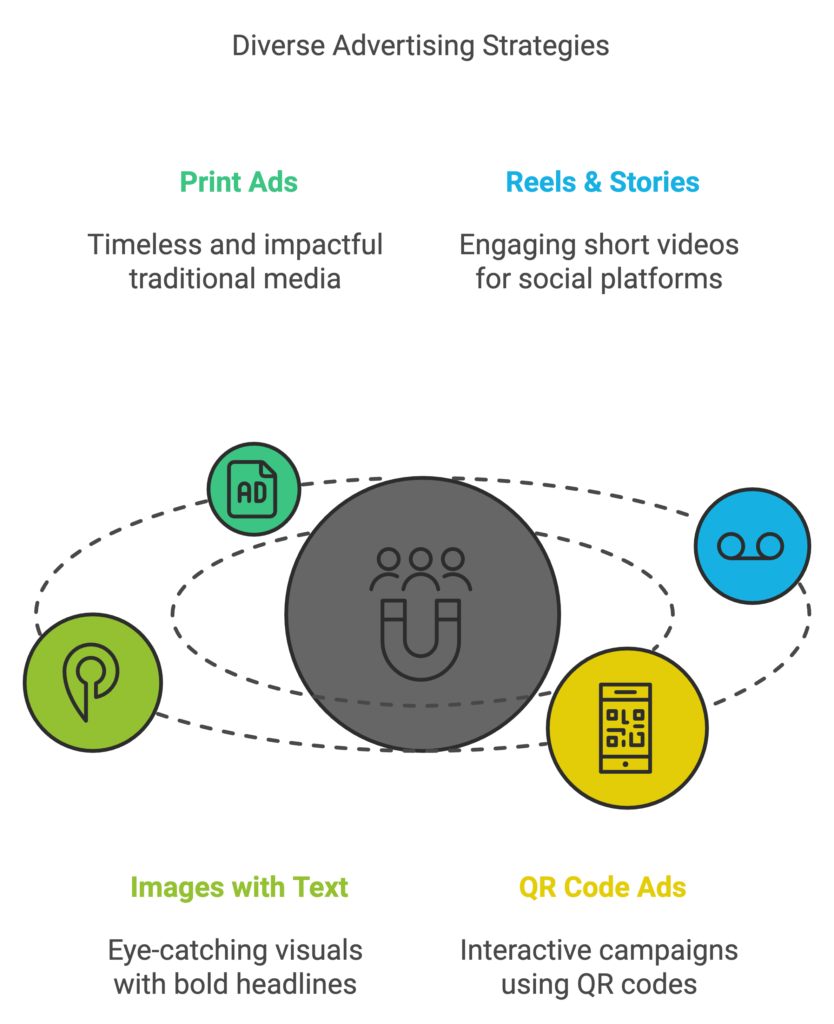What is a Creative Ad?
A creative ad goes beyond mere promotion; it is an innovative approach to presenting products or ideas that captivate, resonate, and inspire. Creativity in ads involves combining storytelling, design, and strategy to leave a lasting impact on the audience. For instance, Coca-Cola’s “Share a Coke” campaign personalized bottles with names, creating an emotional connection and increasing sales by 2% globally.
How to Create Creative Ads?
- Understand Your Audience: Conduct deep audience research to know their preferences, behaviors, and emotional triggers.
- Example: Nike’s “You Can’t Stop Us” campaign resonated with sports enthusiasts, celebrating perseverance during the pandemic.
- Build a Strong Concept: Start with a unique and relatable idea. Align it with your brand message and values.
- Use empathy: People remember ads that speak to their hearts.
- Visual Appeal:
- Invest in professional designs, impactful visuals, or AR/VR experiences.
- Stat: 49% of consumers engage with ads featuring high-quality visuals.
- Add Interactive Elements:
- Examples include QR codes, AR filters, or gamified content.
Why Are Ads Called Creatives?
The term “creatives” reflects the artistic process behind advertisements. Unlike functional communication, creative ads aim to evoke emotions, build brand recognition, and drive consumer action. For example, Apple’s “1984” Super Bowl ad wasn’t just a commercial—it was a cultural moment, defining the launch of the Macintosh computer.
Ad Creative Vs Ad Concept: What Is The Difference?
- Ad Concept:
- The idea or theme behind the ad.
- Example: Dove’s “Real Beauty” celebrates diversity and body positivity.
- Ad Creative:
- The execution of the concept through visuals, text, and design.
- Example: The body-positive visuals in Dove’s campaign ads.
How to Make Winning Creative Ads
- Leverage Emotions:
- 75% of consumers purchase based on emotional triggers. Ads like John Lewis’ Christmas campaigns tug at heartstrings to boost brand loyalty.
- Focus on Value Proposition:
- Highlight what sets your product apart.
- Example: Volvo’s “Epic Split” ad showcased the precision of its trucks with stunning visuals.
- Experiment with Platforms:
- Create dynamic content tailored for specific channels, like Instagram reels or LinkedIn carousels.
- A/B Testing:
- Analyze what works best for your target audience.
Creative Ad Types

Dynamic Ads vs. Static Ads in Creative Advertising
| Dynamic Ads | Static Ads |
| Tailored content that adapts to audience preferences (e.g., Amazon’s personalized product ads). | Fixed visuals or messages, suitable for billboards or print. |
Creative Design Thinking in Ads
Design thinking prioritizes innovation and user-centered approaches. It involves:
| Empathy | Understanding user needs |
| Ideation | Generating unique ideas |
| Prototyping | Testing ad concepts |
Example: Airbnb’s campaigns focus on storytelling and emotional connections, built using design thinking.
Creative Ads on Special Days
Special occasions offer an excellent opportunity to tap into cultural moments.
- Example: Coca-Cola’s New Year campaigns feature celebratory themes.
- Tip: Incorporate mixed reality to create shareable experiences for occasions like New Year or Valentine’s Day.
Different Creative Ads for Different Platforms
| Facebook and Instagram | Carousel ads and reels. |
| Professional storytelling campaigns. | |
| Snapchat & TikTok: | AR filters for brand interaction. |
Stat: 67% of marketers believe platform-specific content drives higher ROI.
How AI Is Evolving Creative Ads
AI has revolutionized advertising with tools for:
| Personalization | AI helps create hyper-relevant ads, as seen in Netflix’s personalized recommendations. |
| Predictive Analytics: | Forecast ad performance and audience engagement. |
| AR and VR Experiences: | AI-driven mixed reality ads, like Gucci’s AR shoe try-on feature, boost engagement. |
Fact: AI-powered ads lead to a 30% higher engagement rate compared to traditional ads.
The Role of Mixed Reality in Creative Advertising
Mixed reality bridges the gap between physical and digital worlds. Flam, for example, uses mixed reality to create immersive ads, such as campaigns for brands like Britannia and Freedom Oil. By enabling users to interact with products virtually, these ads create memorable experiences.
Testimonials and References:
Coca-Cola’s Share a Coke Campaign:
- “The personalization of the Coke bottles created a deep emotional bond with customers.” — Marketing Week
Nike’s Just Do It Campaign:
- “This campaign made me believe in myself again.” — Customer Testimonial
Quotes on Creativity in Advertising
“Creativity is piercing the mundane to find the marvelous.” – Bill Moyers
“The best ads don’t just tell you what to buy—they tell you why you should care.” – Unknown
Conclusion:
Creative ads are more than marketing tools; they are brand stories that leave a mark. By embracing innovation, design thinking, and emotional storytelling, brands can create campaigns that resonate deeply and drive results. As AI and mixed reality continue to evolve, the future of creative advertising promises to be even more engaging and impactful.